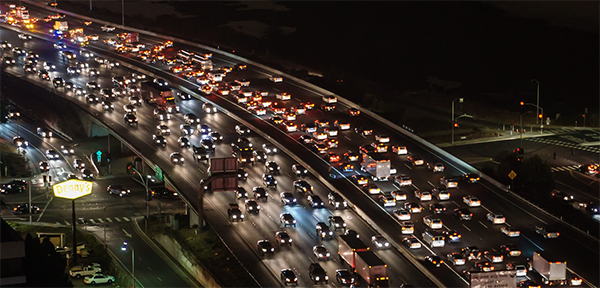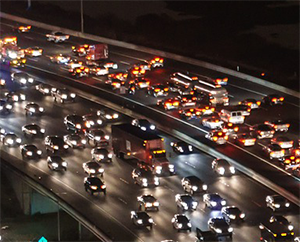“The road,” observes James May, “is infinitely long, but it isn’t infinitely wide.” May is a BBC presenter. He made this comment in a show about micro-cars — Isettas, Messerschmitts, Japanese Kei cars, and so forth — tiny cars that have been touted as a way to reduce traffic congestion. His point is that because the road is not infinitely wide, it doesn’t matter how small you make the cars. Eventually, there will be enough cars to clog the road side-to-side. They will “use up the available bandwidth” of the highway.
Recently, I returned to Silicon Valley for business, as I do periodically. When I originally moved there, I thought there was traffic, but I was wrong.
There is traffic now.
The roads — all of the surface streets and almost all of the freeways — were laid out in the 1950s. America had a population of 180 million people in the 1950s, and Silicon Valley (which hadn’t been yet so named because silicon chips had not been invented) still boasted agricultural land up and down the Peninsula. There were orchards in the center of Sunnyvale as late as 25 years ago.

There are no orchards now. Surface streets are jammed, although not to the stopping point, and there are tie ups on the freeway into the small hours of the morning. Housing construction is booming (as are prices). But the higher and denser and wider that the massive condo complexes are built, the more commuters are spilled onto the roads — those roads designed and built in the 1950s for a national population about half of what we have now and a semi-agricultural Silicon Valley.
There is no more right-of-way to expand into. There are no more freeways to build. Toll lanes fend off only a small percentage of people who would otherwise use them but who must commute nonetheless, somehow. Worse: because for all practical purposes Silicon Valley has no civic center — no downtown to which everyone commutes (apologies to San Jose, “The Capital of Silicon Valley”) — people need to go everywhere.
Self-driving and assisted-driving cars will help keep the roads safer, but they won’t solve the underlying bandwidth problem. I don’t know that there is a good technological solution. It’s not tiny cars.
In Manhattan, the solution is neighborhoods. Supermarkets and the other services of daily life are no more distant than the average person can walk from his residence. Many people don’t own cars. That does not occur in Silicon Valley. You must drive to the supermarket. Compared to Manhattan, Silicon Valley is vast. It extends from just south of San Francisco southward down the Peninsula for 60 or 70 miles until it reaches its current agricultural frontier in Gilroy (garlic capital of the world), which is rapidly gentrifying. It extends into the East Bay, and even laps over the mountains into the Central Valley beyond. Commutes can last three hours — one way.
If Silicon Valley remains popular and central to a vibrant high-tech industry, time will solve this problem. Mixed-use complexes — where supermarkets and other services as well as offices are within a short walk of where people live — will take over the single-house post-war suburbs that now cover the valley floor. It will take another 50 years to make such a transformation. I would say 100 years, but things move fast in Silicon Valley. Fifty years is fast to transform one type of architectural spirit into another.
But… people still want and like to move from point A to point B for whatever reason. They’re not going to sit in a residence two minutes by foot from shopping and work and go nowhere else. We may reduce or eliminate the commute load, but the bandwidth issue is still there. I don’t believe the solution is buses or trains or subways. Those solutions are packet-based: you move a bus full of riders from point A to point B, stopping every so often. You can increase the number of buses — but nobody likes waiting for a bus or a streetcar and traveling on someone else’s dictated schedule and route. This is the urge that made the automobile so popular.
Writer Robert Heinlein suggested in a story written in the 1940s (The Roads Must Roll) that highways could be replaced with a network of moving conveyor belts — rolling roads. Individual people would get on, move up to the speedier belts for longer journeys, and get off when they neared their destinations. This solution, while fictionally interesting, still suffers from the bandwidth problem, although much less so than a freeway clogged by two-ton vehicles each containing a single rider. Given enough population, I could envision a people-jam. Think New Years’ Eve, Times Square.
I don’t believe there is a quick solution. Density imposes its own requirements, and they are not the automobile-based solutions of 1950s suburbia. In Silicon Valley, we see the suburban town of the 1950s in the process of transforming itself into a city of the 22nd century. But it’s painful. It may get more painful in the decades to come, as we cling to our 20th-century — and even 19th-century — ways.
I loved the 20th century — or what I saw of it. But we don’t live there anymore.


